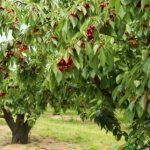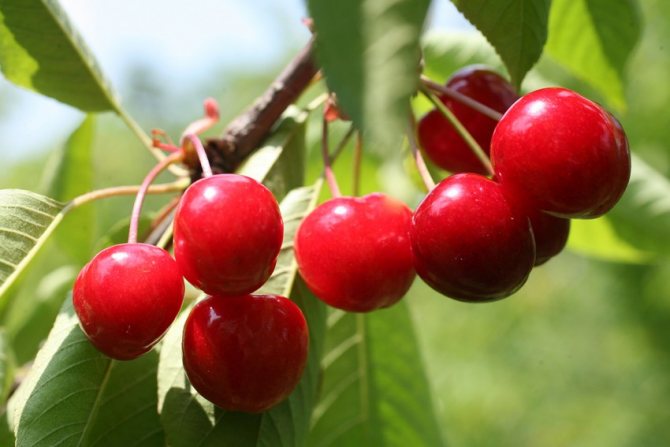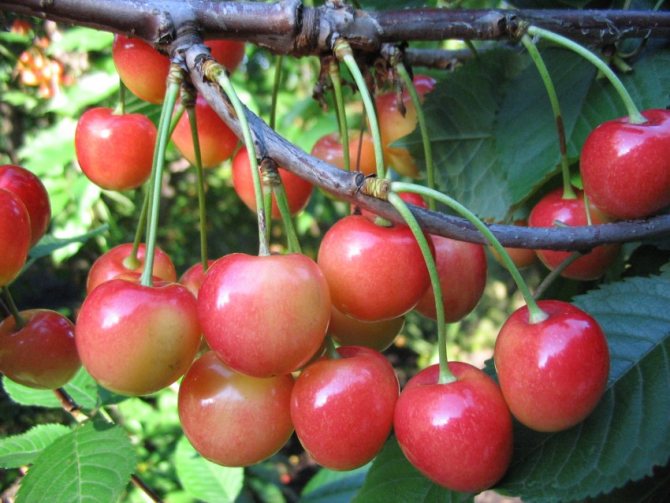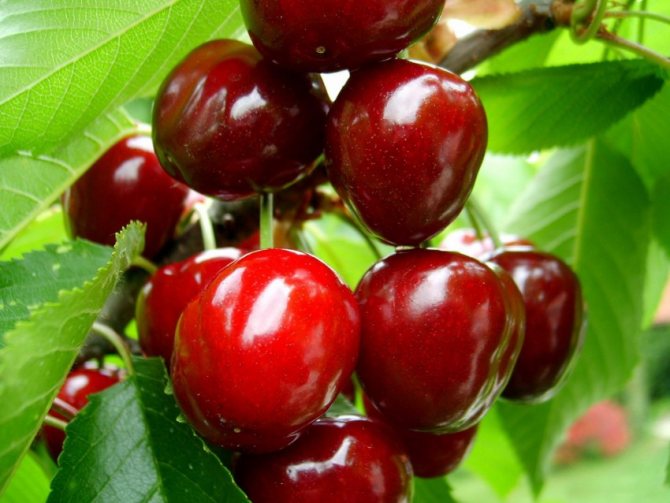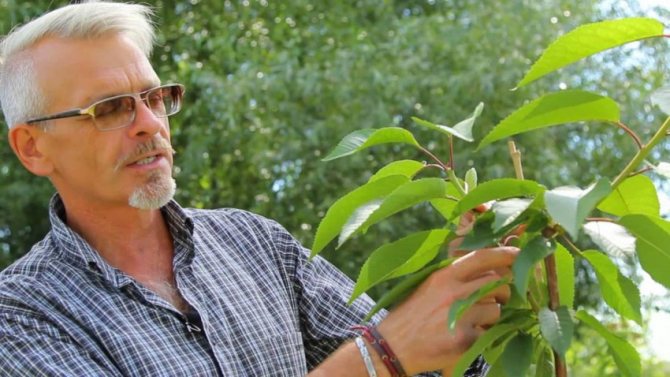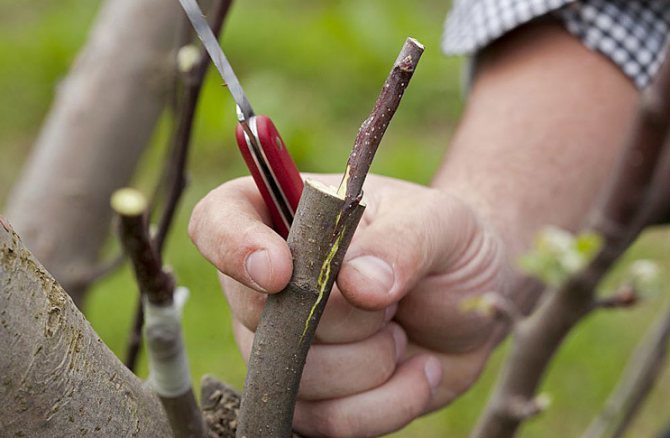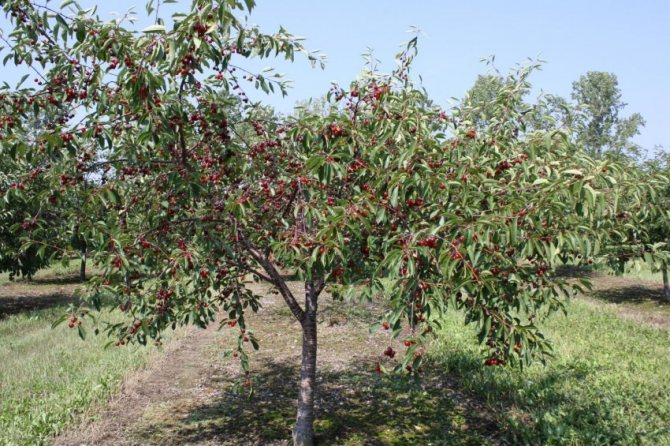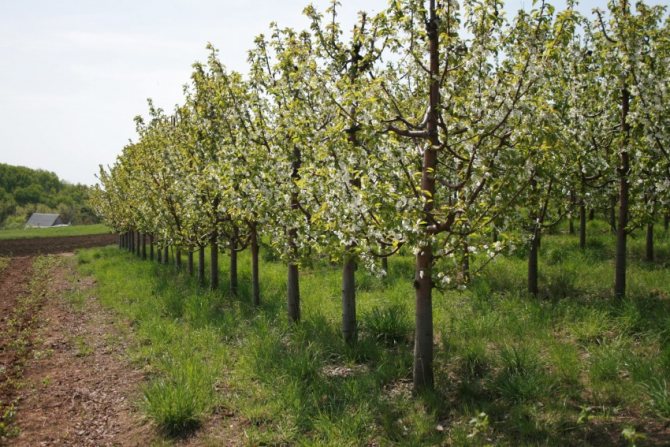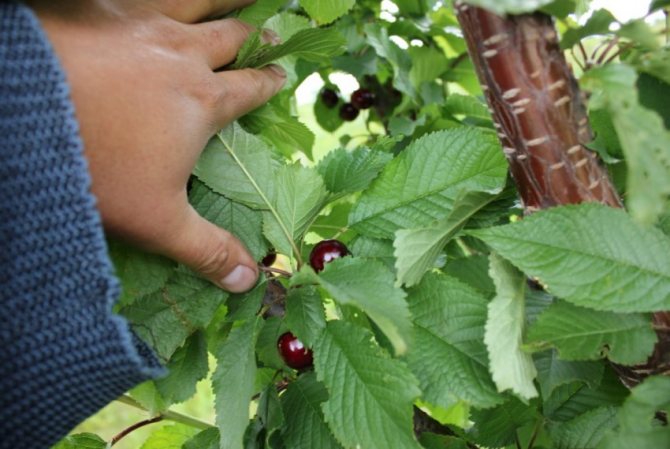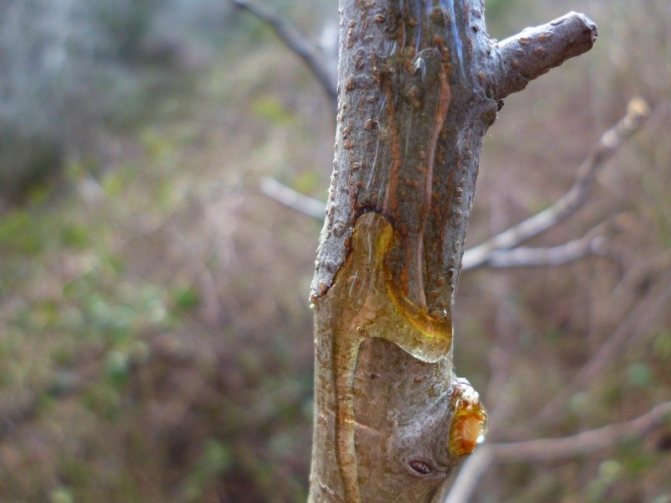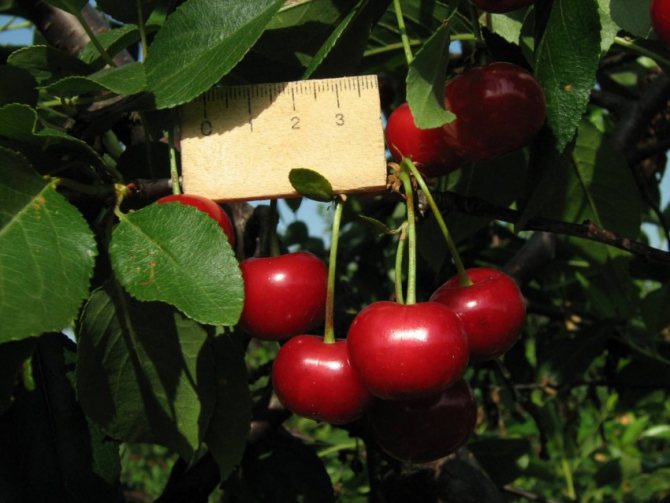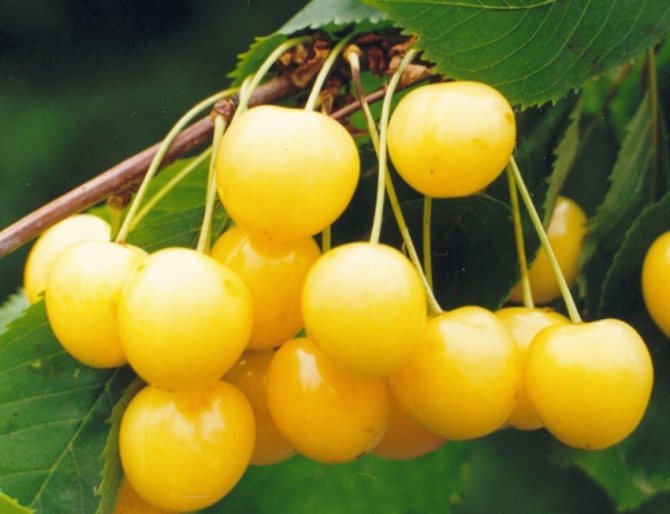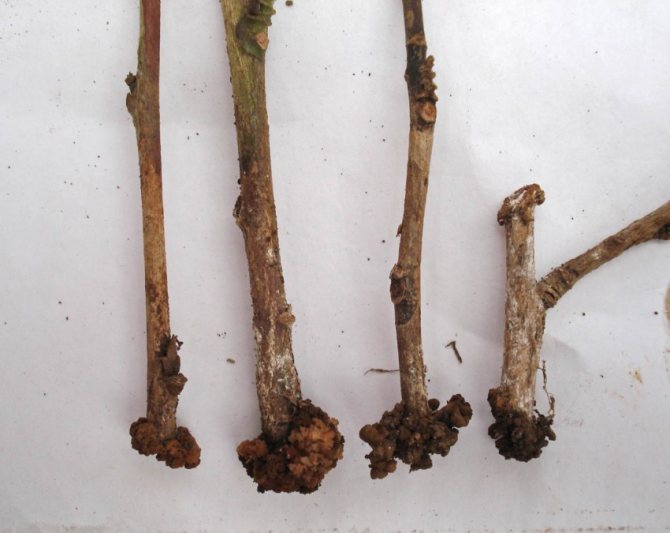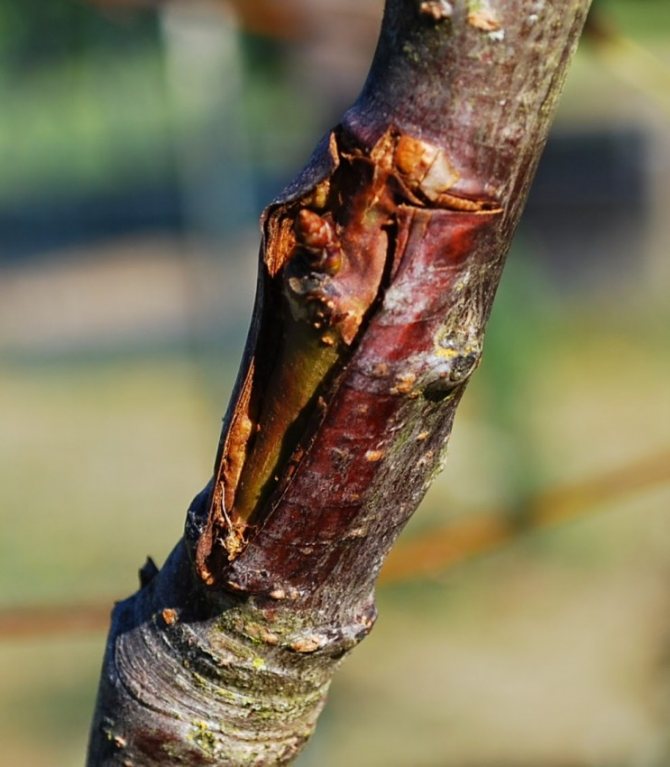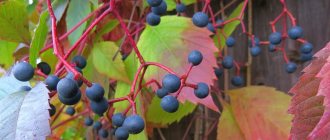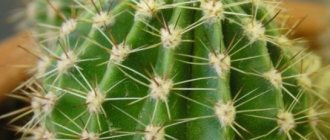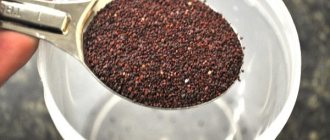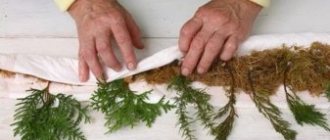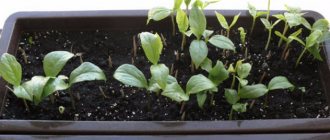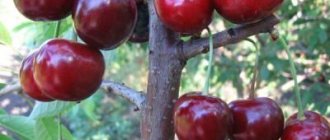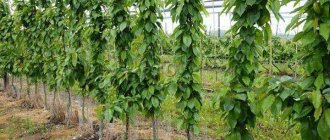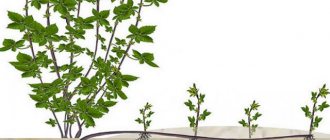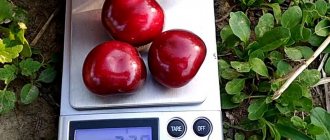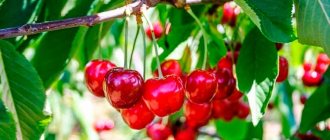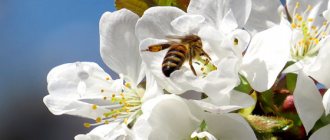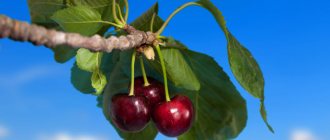Choice of wood material
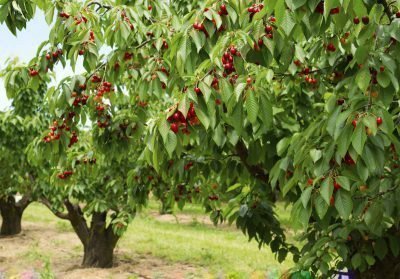
Summer residents are engaged in reproduction of stone fruit crops in early summer. The ideal time for these events is the first decade of June. During this period, the active growth of trees slows down. Important changes are taking place with the green shoots of sweet cherry trees. The bases of annual cuttings are lignified.
Some summer residents are expanding the cherry family in the spring. You can try propagating trees in May, but the shoots are still too tender during this time. They grow rapidly and the budding will be slow.
It matters from which tree the cuttings were taken. If the cherry suffers from a deficiency of nutrients (nitrogen, phosphorus), the plant material taken from it will be weak. Plants overfed with fertilizers are not suitable as a mother tree. Make sure there are no fungal infections on the tree. There is no point in taking shoots from sick cherries.
We will consider other rules for preparing samples in detail below.
- Do not take cuttings from old cherries. Such material has a low chance of rooting.
- If you can choose, take cuttings from stone fruit crops that began to bear fruit 2-3 years ago.
- Shoots are not cut from the top of the mother tree. Twigs growing on the tree below will suit you. It is necessary to take shoots from young, strong branches.
- The length of the shoots should not exceed 30 cm.
- To grow a young tree from a shoot, you need to cut straight, well-developed cuttings.
- Make sure that there are 3 leaves along the length of each cutting. There should be another 3 cm at the bottom of the shoot.
- It is recommended to separate the rooting samples from the mother tree in the morning (before sunrise). Also, this procedure can be done in the evening after 6 o'clock.
- It is important that there is no heat while cutting the shoots.
- Cut samples from the tree with a sharp, clean knife.
The bottom cut is made at an angle of 45 ° C. The upper cut is done differently: at a right angle. It is important that the latter is slightly higher than the kidney.
With the help of shoots, not only the cherry tree can be propagated. This method is suitable for growing cherries and other stone fruit crops.
Some summer residents are in a hurry to root the shoots immediately after they have been cut from the tree. If this is not possible, the plant material is placed in containers with clean water. It is important to make sure that no water gets on the leaves. You can keep the cuttings in a cool dark place. To prevent the leaves from absorbing a lot of water, cut them in half.
The subtleties of growing a cherry tree
If you are worried that there is only one varietal cherry on the site, start growing this stone fruit crop. Cherry trees can be grown in the same ways as cherry trees. Different types of stone fruit trees can be obtained with the help of seeds. If you live in a middle climatic zone, you should not take up the cultivation of a thermophilic variety from seeds.
Cherries obtained by the shoots are distinguished by their high endurance. These plants are more prone to crown thickening than those grown by grafting.
Rooting
Before planting cherry shoots in the soil, they must be treated with special preparations. To stimulate growth, "Heteroauxin" is used. For 1 liter of water, you need to take 100 mg of working fluid.The cuttings should stand in the solution for 14-17 hours. Then they can be rooted.
The best substrate for rooting green splendor is soil with a small amount of manure and river sand. The soil must be breathable.
So that you do not have to say goodbye to green shoots, it is important to prevent hypothermia. In spring, many cuttings die due to frost. Too much heat also inhibits root formation. The best rooting temperature for green specimens is 27 ° C. In summer, cuttings need moisture. They need to be sprayed from time to time. Future trees need generous and regular watering. The water should not be very cool. Rooting occurs 20-40 days after placing the cherry processes in the soil.
To ensure the full development of the root system of cuttings, they should be fertilized with small doses of phosphorus fertilizers. Having carried out such a top dressing twice over the summer, you will help the cherries to take root, and reproduction by cuttings will be successful.
Tricks for Building Powerful Roots
An original and effective method has been developed that allows to increase the percentage of rooting of shoots by 30%. This can be achieved by discoloring the wood at the bottom of the cutting. Thanks to the processing of a fragment of wood tissue with cuttings, an interesting metamorphosis occurs: their cambial cells are reborn. The cuttings then develop a strong root system. It is easy to grow a healthy tree from this.
The original scientific method is rather complicated, but summer residents have successfully adapted the innovation, adapting it for use at home. On the tree, branches are chosen that will become cuttings. After waiting for the shoot to develop the third leaf, you need to wrap the base of the future cutting with black foil. For this purpose, you can use fabric-backed duct tape. Its width should be about 4 cm.
The shoots wrapped in foil are left alone for 9-11 days. Then the cuttings are cut from the tree. After removing the dark film from them, they are planted in the soil. It is not difficult to grow young trees from such specimens.
If you want to have several trees of your favorite variety on your site, propagation of cherries by cuttings at home is what you need. Stone fruits are propagated in summer. Sometimes gardeners do this in the spring, at the end of May. It is worth noting that growing cherry tree babies is not an easy task. It is important to choose the right time for these procedures. It matters from which part of the tree the samples were taken.
Not all gardeners know what to do with green shoots. Proper preparation of the cutting increases its chances of successful rooting. To stimulate the formation of the root system, the cuttings should be kept in the Heteroauxin solution for 14-17 hours. Overheating and hypothermia of the cuttings should not be allowed. Future trees need increased watering. The rooting process takes 30 days.
Possible difficulties
Despite all the advantages, the process has vulnerabilities. Growing young trees by means of shoots has the following disadvantages:
- since cherry trees are propagated in summer, rooted plants do not have time to gain strength before the onset of winter, you will have to take care of warming young cherries with agrofibre in the cold months;
- the rooting process is long;
- cuttings need constant abundant watering;
- 10-12% of cuttings are rooted, therefore, if you are going to propagate a stone fruit culture by cuttings, be prepared that you have to cut and save a lot of samples.
What cuttings are suitable
For breeding and rooting, cuttings from the tops of last year's or shoots of the current year of development, with a diameter of 4-5 millimeters, are suitable. The lignification process has just begun. In addition to cuttings taken from shoots, root shoots can be used.Do not confuse them with offspring, which are small cherry bushes.
Root processes
They are sections of the root 12-15 centimeters long, with a growth bud. The advantage of such planting material is that it does not need to be rooted - the plants already have a root - you need to try to grow an even, strong central shoot. From such processes, own-rooted seedlings of the required diameter are obtained - more than 7 millimeters. Harvesting root cuttings is laborious: in order to breed several varieties, you need to look for and dig up the root system of a large number of trees.
Green shoots
These shoots have the highest vigor. The top of them retains their green color and continues to grow, which is why they are called "green". The surface of the growing branches at the base already has areas of burgundy bark. It is much easier to plant such cuttings than root cuttings.
Many gardeners ask the question, is it possible to take cuttings from the growth around the mother tree, since the shoots on the plant itself bear the crop? The answer is no, as there is no certainty that the mother plant did not grow out of the graft.
Landing
Planting holes are dug with a diameter of 70–80 cm and a depth of 50–60 cm. Moreover, when choosing a soil, its upper layer is laid separately, and the lower, infertile, is removed altogether. A stake is stuck in the middle of the pit, in order to then tie a tree to it. A mound is poured around the support from a mixture of fertile soil, humus or compost (10-15 kg), phosphorus (200 g) and potash (60 g) fertilizers. Next, the seedling is placed on a mound, carefully spreading the roots, and covered with the same mixture. You need to plant so that after the soil settles, the root collar remained at ground level... The trunk circle is mulched with compost or humus.
Having learned to propagate and plant once, you can, if necessary, update your cherry garden, replacing dead trees, or replenish it with new varieties. The ability to grow planting material is also valuable because you will always be sure of its quality.
Harvesting cherry shoots
In the process of harvesting planting material, follow a strict order. Do not cut branches from different trees at the same time. Until you've finished cutting one variety, don't move on to the next. Tie the shoots in bunches and hang tags indicating the variety.
Timing
It is advisable to breed cherry varieties during the summer. Therefore, the harvesting of cuttings is carried out from late spring to early autumn. In spring, the best period comes at the end of May, after flowering. In this case, cuttings are taken from the upper part of the shoot of the last year, if possible without ovaries. In the summer, it is favorable to take cuttings from the shoots of the current year. In autumn, the material is harvested after leaf fall, at the end of October.
How to choose planting material
When choosing ready-made cherry seedlings, you can determine how they were grown. You need to take a seedling and carefully examine the root system. Fibrous indicates that the seedling was propagated vegetatively, from cuttings, the pivotal one - by seed propagation. If just above the root collar there is a slight bend in the central shoot, then the seedling has been grafted.
Rules for harvesting cuttings
Before cutting off the cuttings from the mother plant, it is watered abundantly in 1-2 days to saturate the tissues with water. In the case of autumn selection, the procedure is performed after water-charging irrigation. During the summer selection of cuttings, they must be soaked in clean water for 1.5-2 hours, then the lower ends are treated in a solution of a root formation stimulator - Kornevin or Kornestim, and planted in the seedling department.
In the fall, the cut material is processed for one hour and stored.
The length of the shoot segments is 9-12 centimeters. 3-4 buds should be left on each cutting. A straight cut 5 millimeters lower is made under the kidney. Roots will form at the node.Above the upper kidney, an oblique cut is made in the same direction as it is facing. The leaves are shortened by 1/3. If it is not possible to immediately plant, the cut shoots are sprayed with water from a spray bottle and wrapped in foil or packed in a plastic bag.
Important! Freshly cut cuttings quickly lose moisture, which drastically reduces the chances of rooting.
How to properly store cuttings at home
For winter storage, cuttings are laid, cut in the fall - at the end of the growing season, when the shoots have finished their development and entered the dormant stage. The handling of material intended for storage is as follows:
- shoots are kept in water at room temperature for 1 day;
- processed in 3% ferrous sulfate for 30 minutes.
Then such a blank is packed in bags and put into the refrigerator, on a shelf for storing vegetables. In this form, plant material is stored at a temperature of 1-3 degrees until February.
Rooting methods
During the summer, rooting is carried out in the nursery, in the open field. You can root a cherry stalk in a soil substrate or in water. There are more nutrients in the substrate, more air is available, so the results are better when rooting in the soil.
Let us consider in more detail the rules for planting cuttings in a school, which can be organized in the summer at a summer cottage or in a personal plot, and in winter - in a container in an apartment or on a heated loggia, balcony.
Landing
Agrotechnology for growing cherry seedlings provides for the organization of greenhouse conditions with 100 percent air humidity around the cuttings. This moment should be foreseen in advance and prepare plastic wrap or glass jars for organizing the microclimate.
At what age to transplant
When planting shoots in June, by September they have already taken root. But not all young plants begin to grow actively. For many, growth processes are inhibited, so the seedlings are left in the school until next year. At the age of two, they are best suited for landing in a permanent place. For the winter, they are covered with tops of vegetable crops.
Cuttings planted in February from last year's shoots develop faster - they are transplanted into open ground in May, and by September they are ready for planting in a permanent place.
Requirements for the composition of the soil
Rooting is best done in light soil. For the nursery, take 1 part of garden land, mix with 1 part of peat and 2 parts of coarse river sand. You can add 20 grams of superphosphate and 30 grams of potassium sulfate to the substrate per 1 kilogram of soil. All ingredients are well mixed.
Choosing a landing site
When the nursery is placed in the open sun, young shoots can suffer from burns and heat. Therefore, it is better to organize a nursery in partial shade, but future seedlings really need access to light. The place must be protected from winds. It is optimal to choose a slightly shaded area near the wall of the house on the south side.
Layout scheme
Young plants feel better with a large area of air and soil nutrition. Therefore, they should be planted in rows according to the 15 x 15 centimeters pattern. The more space for the bushes, the higher and more spreading the branches will be.
Depth and technology of planting in open ground
Planting depth of cuttings - 3 centimeters. The node with the lower bud should be completely submerged in the soil, half capturing the internode. The substrate is compacted by squeezing the wood as tightly as possible, watering is immediately given. After absorbing water, the bed is mulched with peat 4-5 centimeters.
Soil preparation
Almost any soil is improved before laying an orchard. Since cherries are very demanding on soil fertility, for her this is also relevant. The entire area intended for planting is dug to the depth of the shovel bayonet, while simultaneously applying the following fertilizers:
- Compost, humus or rotted manure at the rate of 10-15 kg per m 2.
- Mineral fertilizers: phosphorus 15–20 g per m2, potassium 20–25 g per m2.
- Lime is added in an amount depending on the mechanical composition of the soil and the level of acidity. On heavy soils with a Ph lower than 4.5, make 750-900 g of lime per m2. On light sandy loams and loams - from 200 to 500 g per m2, depending on the acidity of the substrate.
The above norms of organic and mineral fertilizers are suitable for podzolic soils. For chernozems, the amount of compost and potassium is halved, and the amount of phosphorus is increased to 20–25 g per m2.
Seed germination
It is easy to do this at home, only the process will take a long time:
- First of all, it is necessary to select bones, which should be healthy externally, without visible damage and traces of insect activity. They are selected from the largest and most delicious berries.
It is not worth the risk of growing cherry pits from the market. The seedling will grow, but its characteristics may not be suitable for the growing region, they may freeze out.
- To obtain high-quality planting material, it is necessary to plant not 1-2, but many copies. This is necessary in order to subsequently choose the strongest and healthiest seedlings.
- Often, a plant grown from a stone produces fruits that are completely different in taste and other characteristics.
It is not easy to breed cherries in this way, you need to show patience and diligence to get the result.
Spring disembarkation
In the fall, it is necessary to prepare a place for planting. Choose a lighted place, protected from drafts. Humus and mineral fertilizers are introduced. To awaken, the bones are laid out in wet sand and kept at a temperature of 0 ⁰С.
In the spring, when the snow melts, the soil warms up a little, you should plant the bones in the ground. Only the best specimens are selected. For best results, they are soaked in a growth promoter.
It is necessary to sow in rows, to facilitate the care process, the distance between the grooves is 40 cm, between the seeds 15-20 cm.The planting depth is 2-3 cm.
Autumn planting
The seeds selected for planting are stored in a plastic bag in the refrigerator. The landing is planned for October. The garden bed is prepared similarly to planting in the spring.
The grooves are made 5 cm deep, the distance between the bones is 15 cm. Sprinkle well with soil on top. This is necessary so that the bones and sprouts that arise in them do not freeze in winter.
In the spring, after the emergence of seedlings, plantings are thinned out, leaving the strongest sprouts.
Dates for planting
It all depends on the region of cultivation. In the south, they try to plant cherries in the fall. It calmly takes root, hibernates and begins to grow in the spring. In the northern and central regions, on the contrary, they tend to plant seedlings in the spring. In the summer they harden and prepare for winter. Having overwintered well, the plants are gaining strength and growth, starting in spring.
During the rooting period, the gardener monitors the condition of the tree and applies the necessary agrotechnical techniques in a timely manner.
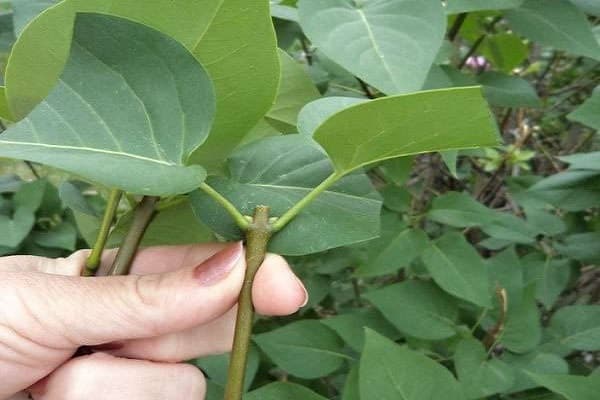

Breeding technology with green cuttings
This method of propagation of cherries allows the plant to retain its ability to frost resistance, as well as become more resistant and capable of rapid recovery.
For this breeding method, branches are selected that are on the lower tier. Each should have 4-5 leaves. You need to cut them off at an angle, with a sharp object, trying not to damage the bark.
The lower leaves are removed, this will help to root better. The branches cut from the cherry are placed in a growth stimulator for a day.
The soil is mixed in a 1: 1 ratio of peat and sand. A layer of coarse river sand 5 cm thick is poured on top, everything is mixed well and green cuttings are planted. To speed up the process, they create a greenhouse effect, tighten the soil with a film.
Reproduction by air layers of sweet cherry is practiced by many gardeners. This method consists in the following. A fruiting branch is selected, several cuts are made on it. Then a plastic bag with soil is tied to this place, which is regularly watered.
Over time, the branch takes root, the branch is cut and planted in another place. Such seedlings retain all the features of the mother tree, including the taste of the fruit.
Do-it-yourself technology for obtaining fruit cherries at home
Sweet cherry is gradually expanding its cultivation area. Thirty years ago, it was believed that cherries could not be grown at the latitude of the Moscow region. The southern plant did not want to grow in a climate with cold winters. In the summer, the sum of temperatures was not enough to set the sugar. In the mid-nineties, varieties were developed that were adapted for cultivation in the central zone of Russia.
Gardeners of the Middle Lane quite successfully grow cherries on their plots. The desire to have more such trees is explained simply: adults and children like the tasty berry. Having experience in real cultivation and reproduction of cherries, I decided to share my experience. I hope readers find a suitable way for themselves.
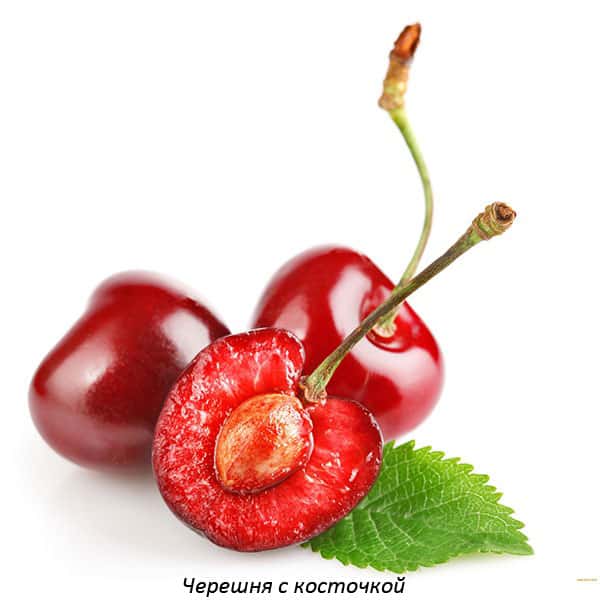

Tree care after rooting
When a cherry sapling has taken root, it should be properly cared for. Timely activities will help to avoid some problems. Growing cherries need feeding, watering, loosening and pruning.
Watering mode
Rooted seedlings should be watered frequently, avoiding drying out or waterlogging of the soil. The first time it is watered once a week, then reduced to 1 time in two weeks. But while increasing the amount of water for one seedling.
Soil and foliar feeding
Without fertilizers, the plant will not be able to fully develop. Top dressing applied on time will help form a healthy root system and an equally strong aboveground part of the seedlings. The basis of the future harvest.
If everything is done correctly during planting, then the first year the cherry will not need mineral fertilizers. Organic matter is introduced during planting, it is thoroughly mixed with the earth for backfill.
In subsequent years, it is recommended to feed the plants with organic matter several times a year. You should carefully monitor the appearance of the seedling and, based on observations, determine what the growing cherry is lacking.
Fertilizers are applied along with watering or one day after it. Spraying or foliar feeding is carried out in the evening or cloudy weather. This is done no earlier than in the second year of the plant's life.
When processing by the foliar method, it is necessary to use chemical protective equipment, gloves, goggles, and a protective suit.
In any business, it is important to comply with the norm, it is better to underfeed the plants than overfeeding them.
Crown formation
It is not enough just to plant a seedling, weed and water. It is necessary to shape the tree correctly. To get a sweet cherry with a developed crown, you need to start forming from the first year of the seedling's life.
The features of pruning depend on the variety, but there are general subtleties. Cherry pruning is necessary to increase yields, prevent the appearance of diseases, increase the period of fruiting and improve the quality of berries.
In regions with a cold climate, cherries are formed in the form of a bush, so it can more easily endure severe winters.
It is necessary to form a tree at a young age, when the branches are still easy to bend, direct them at the required angle. If the cherry is grafted, it is necessary to remove all the shoots on the rootstock. Otherwise, she is able to hammer the scion, and nothing will come of the vaccine.
Formation begins from the first year of life of a young tree. Start pruning from the bottom tier. Deletes those branches that are not skeletal. Then the central shoot is necessarily shortened. This is necessary for the formation of lateral skeletal branches. The first year, all side branches are removed from the skeletal ones.
If there is no pronounced central shoot, choose the highest branch and shorten it by 2-3 cm. All lateral branches are cut into 3 buds.
Besides the formative pruning, there is a sanitary one. It is necessary so that the tree does not get sick and does not die. All diseased and deformed branches are removed. It is imperative to process the cut sites with garden pitch.
Insect and disease control
At first, treatment from pathogens and pests is especially relevant. It is difficult for a young, fragile tree to cope with this problem on its own. Therefore, the summer resident needs to carefully monitor the appearance of the seedlings and try to detect diseases in time.
It is easier to carry out timely preventive treatment than to eliminate the consequences later. To combat pathogens, it is recommended to carry out treatment with chemical preparations. But only until the seedling begins to bloom, then it is processed with folk remedies.
In the fight against insects, the installation of traps with special contents that attract and kill insects helps. And also treatment with drugs.
Digging in young cherries for the winter
In order for the tree to endure the winter easier, some gardeners add soil to the seedlings. A layer of earth will help them survive the severe frost and continue to grow with renewed vigor in the spring.
Saplings are buried even if they do not have time to plant. Then a ditch is dug, young trees are made into it and covered with earth until warming in spring.
It is not difficult to grow fruit berries, you must clearly follow all the necessary techniques and requirements. The gardener faces some problems, solving them, he leaves feedback to help others. A novice summer resident looks for answers to questions, finds, successfully applies and becomes more experienced.
Difficulties that can arise when the cherry is propagated in different ways:
- The seedling does not grow. Possible reason is the lack of fertilizers, moisture.
- Does not take root. You need to make sure that this is the case. Then take action. Treat with a nutrient mixture, apply mineral fertilizers.
- Sweet cherry does not bloom. It is possible that mistakes were made during planting, the root collar was deepened, and more.
When faced with difficulties, the main thing is not to give up. It is necessary to understand the reasons, then try to eliminate them. Everything can be fixed with patience and hard work.
Reproduction of cherries on their own is a big plus. The gardener will be confident in the quality of the tree obtained as a result of the work done.
Cherry propagation method by cuttings
Cutting is the most affordable and fastest propagation method for this berry, however, there are some difficulties that you will have to face:
- Since cuttings begin at the end of summer, in the fall the daughter plant may freeze or weaken.
- You can transfer diseases and parasites that the mother plant had to the new tree.
- The cutting requires a lot of attention and constant watering.
But the propagation of any variety of cherries by cuttings also has advantages:
- The new tree will be similar to the mother tree - just as strong (with proper care), and the berries will taste the same.
- A new garden dweller will bear fruit in less than 5 years.
- A stalk is easiest to buy or cut from a tree.
So, grafting has both weighty pros and cons. If you're willing to give your new plant a little bit of attention and effort, this is a good method for you.
It is better to propagate cherries by cuttings in early autumn or late summer, it is better to take the cuttings from the lower branches. Be sure to treat the cut with a growth stimulant, and cover the cut with ash on the mother plant.
In order for a tree to take root in the open field, a high temperature is required. In August - September, it still holds 20-25 degrees.
A new plant requires constant watering and fertilization.But make sure not to flood the roots too much - otherwise, the process of decay will begin. If you do everything right, the stalk will take root in the cold, it will be possible to huddle it up. After the cherry has overwintered, you should fertilize it again and wait for the first harvest.
The propagation of cherries by young green cuttings is not particularly effective, but if you live in an area where it gets very cold in August, then you can try this method as well. In this case, the cuttings are planted in the middle of summer - at the very peak of the heat.
Green cuttings should be taken from a well-lit part of the crown after that. The incisions are made with a very sharp knife so as not to damage the thin bark. Before planting, the cutting should be soaked in fertilizer.
It is worth planting in pre-prepared soil - fertilize it with peat or packaged mixtures. Such a plant also requires abundant watering and hilling for the winter.
Fundamental rules
It is permissible to breed cherries using different methods. When using the seed method, the tree will be devoid of varietal characteristics. Its fruits will have a change in taste, yield will decrease, and the berries will be smaller. Fruiting begins only after 5 years. When carrying out such a manipulation, it is worth going through the stratification procedure.
Grafting and grafting are considered more effective methods for breeding cherries. In the second case, the summer resident can experiment with plant material. He will be able to obtain cherries without the use of complex techniques and retain the varietal characteristics of the tree.
Cherry grafting in spring, summer and autumn with buds and cuttings
Grafting mature cherry cuttings to mature trees is a good way to propagate this berry in cold areas, and is also the cheapest and proven way to get a mature seedling.
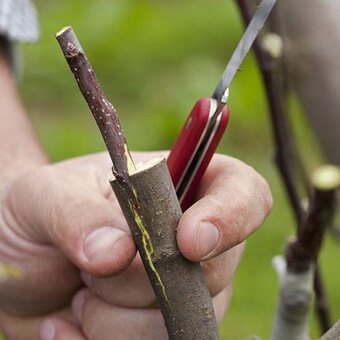

Grafting can be done if you want to improve the taste of the berry, make the tree more frost-resistant or heal it. In this case, it is better to graft on large, healthy trees, not older than 10 years. Better to graft on a tree of a different variety.
On which tree is it better to graft a cherry cuttings:
- on a different kind of cherry;
- on cherries;
- on a plum (cherry belongs to plum);
- artificial rootstocks.
So, if you decide to graft a stalk on a tree of a different variety, then it is better to do this on a strong, unpretentious and frost-resistant tree. You can vaccinate from mid-spring to early autumn. But, if you are a beginner in this business, then it is better to do this during the period when the tree wakes up and begins to actively release sap - in April.
During this period, it is best to inoculate new cherries with a bud - the easiest way to propagate in the spring. To do this, you need to take a green stalk and cut off the shield with the kidney from it. The length of the shield should be about 30 cm. On the plant you are going to scion, the bark is cut approximately along the length of the shield. Part of the bark is cut off completely, and about 10 cm remains on the branch.
After that, the shield is placed under the remaining bark in place of the cut one. The graft and rootstock are fastened together with a plaster, but so that the bud remains open.
Grafting a cherry bud in spring is a good way to propagate a tree for inexperienced gardeners or for those who have old cherries, and they have active juice production only during this period.
You can also do this in the summer. In this case, woody or green cuttings are used.
In order to graft a stiff stalk, copulation grafting is used. It can be done "in a split" (part of the rootstock branch is cut from above, an incision is made inside the branch, and a young plant is grafted there). You can also graft a cherry cuttings in the summer "behind the bark" (the upper part of the branch is cut off, an incision is made on the scion and on the rootstock so that you can connect them like puzzles). Both methods are equally effective - you just have to choose the most convenient for you.
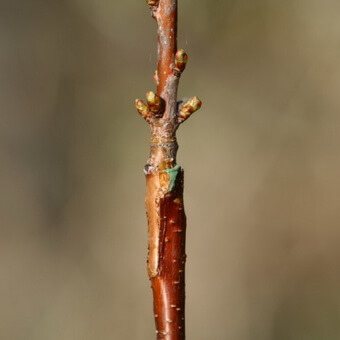

It is imperative to tie the plants to each other with tape, duct tape or plaster. Also, if it is not very hot, it is better to make a mini-greenhouse - wrap the place of the scion in a tight bag. This warmth will help the cuttings take root faster and create comfortable conditions for an adult tree.
Grafting of young cherries in autumn is only good if the tree is frost-resistant. It is necessary to use strong cuttings and graft "in the cleft". Do not do this later than mid-September - otherwise the scion will not take root, it will be "mowed" by the first frosts. In this case, it is better to use tape for fastening, and the bag with which you will wrap the connected parts should be tight and dry.
Supportive pruning
No matter how hard you try, the tree will strive to restore its natural crown, and the shoots replacing the leader will appear the next year. Then they need to be removed annually. If you remove such a replacement shoot in the summer, it can be easily brushed off with your hand, a little later or in the spring it can be removed with a pruner. Skip a year, then you have to cut again. And it's harder to work with a hacksaw than with a pruner, right? Therefore, clean the cherries from unnecessary shoots on time.
The same applies to pruning a plum - and although the plum begins to bear fruit faster (fruit links are formed earlier), it shoots more intensively, so you need to constantly monitor the tree. Not only annually, but several times a season. But now is not about that, let's return to the cherry tree.
The same applies to the side branches - they will also throw up shoots upwards. They are also best harvested in summer after harvest. When shaping the crown by pruning, it is necessary to observe the tiering, form the branches pyramidal, from bottom to top in decreasing order. The branches of the lower tier should be longer than the upper one, otherwise they will fall into the shadow and weaken. Layering must be observed not only when pruning fruit trees, but also when cutting decorative deciduous and coniferous species.
It may seem that pruning cherries in the fall is more affordable for beginners. But why leave fresh cuts for the winter? An unhealed cambium will remain on them and will fall under frost. This is if you cut it in September. And our cherry trees do not shed their foliage for a long time, until November. And, in principle, when the tree is at rest, you can cut it, but ... hands are freezing.
So it is better to carry out the main pruning of cherries in the spring, and in the summer - supporting. If you regularly show a tree what you want from it, as Nikolai Ivanovich Kurdyumov says, it will understand, and it will run less upward, then the fruits will remain in the access zone of the owners. And they are so delicious!

